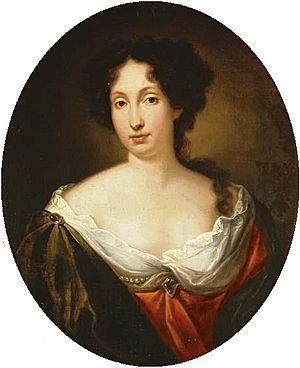Louise de Kérouaille, Duchess of Portsmouth facts for kids
Quick facts for kids Louise de Kérouaille |
|
|---|---|
| Duchess of Portsmouth | |
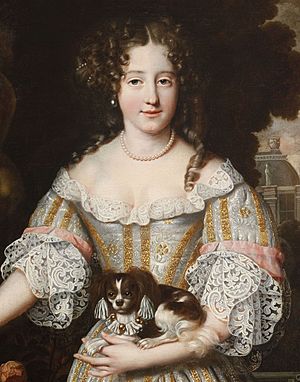 |
|
| Detail from a portrait by Henri Gascard; Google Art Project | |
| Issue | |
| Charles Lennox, 1st Duke of Richmond | |
| Full name | |
| Louise Renée de Penancoët de Kéroualle | |
| Father | Guillaume de Kéroualle |
| Mother | Marie de Ploeuc de Timeur |
| Born | 5 September 1649 |
| Died | 14 November 1734 (aged 85) Paris, France |
| Burial | Church of the Carmelite Convent |
Louise Renée de Penancoët de Kéroualle (born September 5, 1649 – died November 14, 1734) was an important person at the court of Charles II of England. She was a close companion to the king and the mother of his son. She also held the French title of Duchesse d'Aubigny. In England, she was known as the Duchess of Portsmouth.
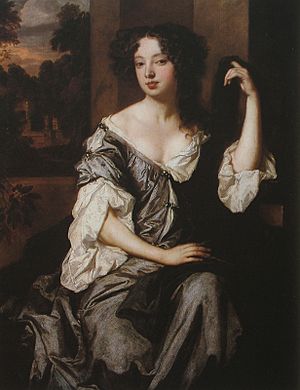
Contents
Early Life and Family History
Louise was born into a noble family from Brittany, France. Her parents were Guillaume de Penancoët, Seigneur de Kéroualle, and Marie de Ploeuc de Timeur. The family name "Kéroualle" was spelled this way by them. In England, people often spelled it "Quérouaille." Both spellings come from the original Breton name "Kerouazle."
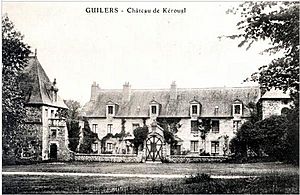
Louise had a sister named Henriette Mauricette. Henriette married two times, first to Philip Herbert, the 7th Earl of Pembroke. Louise's family was well-connected among the French nobility.
Life at King Charles II's Court
Louise first came to the attention of the English court when she joined the household of Henrietta Anne Stuart. Henrietta was the sister of King Charles II of Great Britain. In 1670, Louise traveled with Henrietta to visit Charles II in Dover, England.
After Henrietta's sudden death, King Charles II offered Louise a position. She became a lady-in-waiting to his wife, Queen Catherine of Braganza. Unlike some others at court, Louise always showed respect to the Queen. They had a friendly relationship.
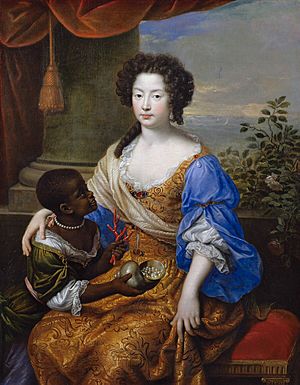
Some people believed that the French court wanted Louise to become close to King Charles II. There isn't clear proof of this. However, when it seemed Charles might favor her, the French ambassador, Colbert de Croissy, strongly supported her. He was helped by Henry Bennet, the Earl of Arlington, and his wife.
Louise was very clever and had a strong will. She appeared gentle and had a "baby face," as one writer described her. She became very important to King Charles II.
In 1672, Louise gave birth to King Charles II's son. The next year, on August 19, 1673, she received several important titles for life. These included Baroness Petersfield, Countess of Fareham, and Duchess of Portsmouth. She also received a lot of money and pensions. In 1681 alone, she received a huge sum of £136,000. The French court also gave her many gifts. In December 1673, King Louis XIV gave her the title of Duchess of Aubigny in France. Her son with the king, Charles (born 1672), was made Duke of Richmond in 1675.
The Duchess of Portsmouth played a role in bringing a young Frenchman to King Charles II's attention. This man had an idea to solve the problem of finding longitude at sea. Although his idea didn't work, it led King Charles to create the Royal Observatory, Greenwich. He also appointed John Flamsteed as the first Astronomer Royal.
Louise received support from the French ambassador because she helped France's interests. King Louis XIV gave her gifts and honors for this. However, many people in England disliked her. This was because of her French nationality and her religion. Her efforts to help France caused strong feelings against her.
Louise understood King Charles's personality very well. This helped her remain important to him until the end of his life. She managed to stay safe during a difficult time called the "Popish Plot" in 1678. Queen Catherine, the King's wife, even helped her. The Queen was thankful for Louise's kindness. Louise also kept her position despite a long illness in 1677 and a visit to France in 1682.
One of Charles's nicknames for Louise was 'Fubbs,' which meant plump or chubby. This was a popular look at the time. In 1682, a royal yacht was built and named HMY Fubbs after Louise's nickname. The French ambassador said that Louise helped King Charles II become a Catholic on his deathbed in 1685. King Charles truly cared for her. On his deathbed, he asked his brother to "do well by Portsmouth." This showed she was one of the three women he thought of at the end, along with the Queen and Nell Gwynne.
Life After King Charles II
After King Charles II died, Louise quickly lost her influence at court. She moved back to France. She only visited England briefly during the reign of James II and for the Coronation of George I.
In her later years, Louise lived in Aubigny, France, and faced increasing debt. The French king Louis XIV, and later the regent Philippe II, Duke of Orléans, gave her a pension. They also protected her from people she owed money to. Louise died in Paris on November 14, 1734, at the age of 85.
Louise in Books and Plays
Louise de Kérouaille appears in several works of literature:
- She is a character in Bernard Shaw's play In Good King Charles's Golden Days (1939).
- She also appears in Jessica Swale's play Nell Gwynn (2015).
- Louise has a small role in the children's novel Eliza Rose by Mary Hooper.
- She is a main character in The French Mistress by Susan Holloway Scott.
- Louise is mentioned in a poem called "A Satyr on Charles II" by John Wilmot, Earl of Rochester.
See also
- English royal mistress


